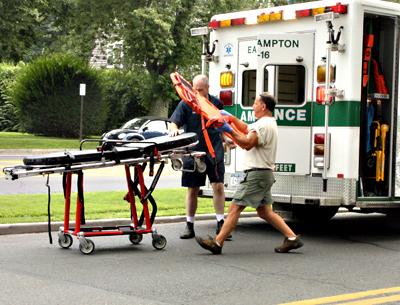Ambulance Services Are Increased

A sign on the Montauk Highway in Bridgehampton reading “We Need Fire Fighters & EMS Volunteers” tells the story succinctly and explains why four of the South Fork’s fire departments have teamed up to do something about its having become harder and harder for its ambulance squads to respond to emergency medical calls in a timely way, while two other departments have worked independently to bolster services.
The East End Ambulance Coalition, a consortium that has met for over 20 years, is meeting the challenge as ambulance calls have reached record highs this summer, creating what Robert Delagi, the Suffolk County emergency medical system coordinator, described as a “financially feasible system” of “tactical” ambulances. Four of the six departments in the coalition have agreed to designate emergency medical technicians on a rotating basis, allowing so-called “tac” ambulances to respond to calls when the individual departments have difficulty doing so.
“Essentially, the tactical ambulances are a form of mutual aid,” said Jeff White, the second assistant chief of the Bridgehampton Fire Department. “It’s a backup crew on a daily basis, where everyone always has someone covering them.” The tac ambulance system went into effect on July 1, with Bridgehampton, Sag Harbor, East Hampton, and Springs taking part. Amagansett has been unable to participate due to scheduling problems, and Montauk has declined because it has new paid paramedics to augment its volunteers.
Mr. Delagi reported that, in addition to the Montauk department, Southampton is among several others in the county that are combining paid and volunteer crews. “These departments offer salaries to always make sure that there are human resources available,” he said.
Phil Cammann, founding chief of the Southampton’s ambulance corps and a volunteer with the Bridgehampton department, and Ed Downes, president of the Sag Harbor Volunteer Ambulance Corps, worked last year to help the coalition come up with short and long-term goals to improve ambulance response times. They have “longevity in their departments,” Mr. Delagi said. “The tac ambulances have not only drastically improved response time,” Mr. Cammon said, “but we’ve also gotten phenomenal commentary from chiefs and public officials on how well they are working.”
According to Mary Mott, an East Hampton Village volunteer and an emergency medical technician instructor, the tac ambulances have created “a win-win situation. . . . It’s a piece that will make the system stronger.”
The East End Ambulance Coalition’s long-term goal, which would, volunteers believe, help improve response time enormously, is to establish a paid interagency first-responder program that would make five daytime paramedics available at all times. Coalition officials are reported to be budgeting for the program in the hope that it can be initiated in the summer of 2014.
That new ways of meeting the need for skilled ambulance crews were necessary became clearer than ever this summer, although Ms. Mott said that “historically, all of the departments have always been looking for new members.” But the numbers are telling. By the end of July, the East Hampton Village Ambulance Association will be nearing 800 calls, Ms. Mott said, in comparison to a total of 1,300 calls in all of 2012.
The volume of calls has continued to go up for several reasons, including worse traffic, more training requirements, and, of course, the fact that the population of the South Fork increases exponentially at this time of the year. “The seasonal population here has just exploded,” Mr. Cammann said. He estimated that there are now between 4,500 and 5,000 calls a year among the six coalition departments.
An increasing problem for volunteers is the amount of false alarm calls, Ms. Mott said. “False alarms hurt the system,” she said. Unnecessary calls will sometimes take two hours of driving to complete, which sometimes means several core crew members are obligated to respond to the call and are unavailable when a real emergency strikes.
Becoming an E.M.T. requires 160 hours of basic life support training. To become a critical care, or advanced, E.M.T., the training takes two years, with 1,500 hours required. It has been reported that there aren’t as many advanced E.M.T.s as the departments would like.
Mr. White, of the Bridgehampton department, said it had started actively recruiting volunteers recently, using radio announcements, fliers, and word of mouth in addition to the highway sign. “Membership is now on the uptick,” he said, reporting that the department has five or six additional volunteers expected to join by fall. In the meantime, he said, “People fill in where they can.”
